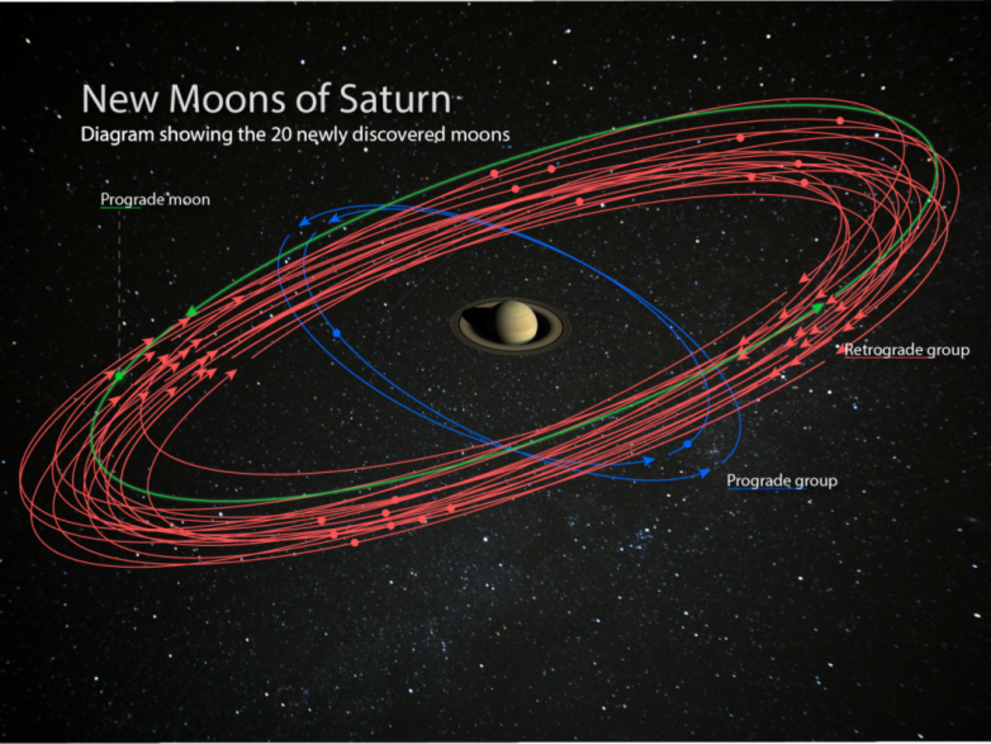20 new moons were just discovered orbiting Saturn and you can help name them
Saturn’s largest moon, Titan, passes the planet undergoing seasonal changes in this natural colour view from NASA’s Cassini spacecraft.
- Twenty new moons orbiting Saturn were discovered, bringing the planet’s total up to 82 moons.
- Saturn now has more moons than any other planet in the solar system, including Jupiter, which has 79.
- Further study of the new moons could help determine how the planet’s outermost moons may have formed from collisions that fragmented large moons into smaller bodies.
- People can submit suggestions for the new moons’ names on Twitter, pulling from Norse, Inuit, and Gallic mythology.
Saturn has unseated Jupiter as the solar system’s most moon-bearing planet, the Carnegie Institution for Science announced on Monday.
Scientists discovered 20 previously unknown moons orbiting Saturn, which gives Saturn a grand total of 82 moons, flying past Jupiter’s 79.
NASA's $1 billion Dragonfly drone mission will look for signs of life on Saturn's moon
The discovery unlocks a trove of possible new hints at how Saturn and its moons became what they are today.
“Using some of the largest telescopes in the world, we are now completing the inventory of small moons around the giant planets,” Scott Sheppard, a Carnegie astronomer who led the discovery team, said in a press release. “They play a crucial role in helping us determine how our solar system’s planets formed and evolved.”
Each of the newly discovered moons is about 3 miles (5 kilometers) in diameter, and 17 of them orbit in retrograde, or in the opposite direction of Saturn’s rotation. One of them is now the farthest known moon from Saturn.
 An artist’s conception of the 20 newly discovered moons orbiting Saturn.
An artist’s conception of the 20 newly discovered moons orbiting Saturn.
The discoveries join three groups of Saturn’s outer moons, clustered by the angles at which they orbit the planet. The retrograde moons join the Norse group (all named after Norse mythology), while two others join the Inuit group (named for Inuit mythology), and the final moon goes with the Gallic group (again, mythology).
Scientists think each of those groups may have come from a larger moon that broke apart into smaller bodies.
“This kind of grouping of outer moons is also seen around Jupiter, indicating violent collisions occurred between moons in the Saturnian system or with outside objects such as passing asteroids or comets,” Sheppard said.
The new Gallic moon orbits much farther away than its companions though, suggested that something has pulled it outward, or that it didn’t come from the same collision as the other moons at all.
Further study can help determine what sort of collisions created the groupings we see today, and what the conditions around Saturn looked like at the time.
Scientists discovered them. You name them.
The researchers observed the new moons with the Subaru telescope atop Mauna Kea in Hawaii. They could watch the moons orbiting Saturn, as in the below animation Sheppard made using images taken one hour apart by the Subaru telescope. The previously unknown moon (highlighted by orange bars) moves against a backdrop of stars and galaxies that appear still because of their distance.
Following the discovery of more moons orbiting Jupiter last year, Sheppard and the Carnegie Institution held an online competition to name them. They’re taking the same approach with this new group of moons.
“I was so thrilled with the amount of public engagement over the Jupiter moon-naming contest that we’ve decided to do another one to name these newly discovered Saturnian moons,” Sheppard said. “This time, the moons must be named after giants from Norse, Gallic, or Inuit mythology.”
People have already started sharing their name ideas on Twitter. American Mensa, an organisation for people who score in the top 2 per cent on the standardised intelligence test, suggested the name “Moony McMoonface” in reference to an online submarine-naming competition gone gloriously wrong, but given the criteria, that probably won’t happen.
Others suggested names along Sheppard’s guidelines, including the hunter-warrior Fionn from Irish lore and Sila, the Inuit god believed to govern life and breath.
To submit your suggestion, tweet it to @SaturnLunacy with the hashtag #NameSaturnsMoons.

